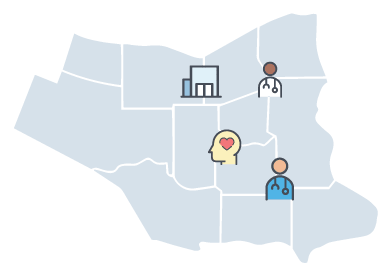Emergency and Urgent Care
Share This Page
Share This Page
Hours at the Urgent Care Centres in Fort Erie and Port Colborne are 10 a.m. to 8 p.m. daily. They are subject to change, please check our website regularly for updates.
IMPORTANT: The Port Colborne Urgent Care Centre will be closed on Wednesday, Jan. 7. It will reopen Thursday, Jan. 8 at 10 a.m. and resume regular hours.
If you think you or a loved one is experiencing a medical emergency, call 9-1-1 right away or come to the nearest Emergency Department.
Primary care should be your first point of care if you do not need emergency care. This includes family doctors’ offices, walk-in clinics, nurse practitioner clinics, community health centres, pharmacies, mobile units and other healthcare options. Using any of these options can help you and your loved ones access the care you need on a timely basis and, whenever possible, avoid an unnecessary visit to the Emergency Department.
If you have a concern that cannot wait for a scheduled medical appointment, visit one of our Urgent Care Centres. Our Urgent Care Centres in Port Colborne and Fort Erie operate from 10 a.m. to 8 p.m. You can also access virtual urgent care without leaving your home by visiting Urgent Care Ontario.
Emergency Departments provide 24-hour access to care for people experiencing trauma, serious injury or serious illness. Patients with the most urgent needs are always seen first, even though they may arrive after other patients. Niagara Health operates Emergency Departments in Niagara Falls, St. Catharines and Welland.

There are many services available in our community.
Niagara region is home to a network of healthcare services and providers available to you.
Please participate in our Patient Experience Survey
Submit your contact informationThe NOHT-ÉSON’s Resource Navigator is a great resource to local and provincial services, pointing you to health and social care resources in your community.
Our teams treat patients for non-emergency injuries or illnesses like sprains or strains and minor cuts. Many of the conditions for which people seek care at Urgent Care Centres are ones that are typically managed by primary care.
Fort Erie Complex and Urgent Care Centre, 230 Bertie Street
Port Colborne Complex and Urgent Care Centre, 260 Sugarloaf Street
If you need help travelling between Fort Erie and Port Colborne, the Niagara Region is providing free transportation. Please call 905-980-6000 ext. 3550 or 1-800-263-7215 to book a ride.
Our Emergency teams treat patients with serious and life-threatening conditions.
Marotta Family Hospital, 1200 Fourth Avenue
Niagara Falls Hospital, 5546 Portage Road
Welland Hospital, 65 Third Street
Emergency Department vs. Urgent Care Centre
Understanding the types of conditions that can be treated in an Emergency Department and Urgent Care Centre can ensure you access the right care you need. Team members from the Fort Erie Urgent Care Centre share where to get treatment for common ailments.
All our infection prevention and control measures are in place to maintain a safe environment and must be followed by everyone.
To provide the best quality of care across the community, Niagara Health has worked with Niagara Emergency Medical Services (NEMS) to implement updated Fit2Sit protocols that will assess each patients’ acuity and determine their placement.
Please note that all patients waiting for care will continue to be closely monitored. Patients in the waiting room are asked to contact triage staff if their condition changes.
